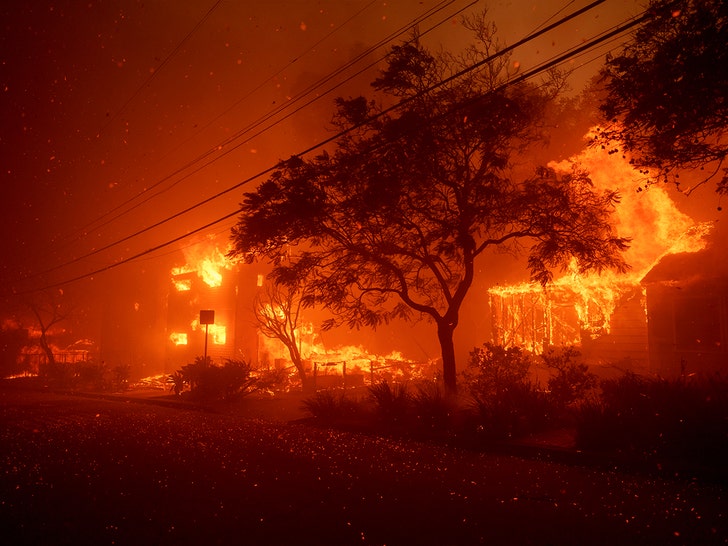Lifestyle
'It’s been insane': Amid fires, hotels from O.C. to Palm Springs see a rush of Angelenos

January is usually an easy month to book a Southern California hotel room. Not this year.
Driven by the fires that have uprooted hundreds of thousands of L.A. County residents, legions of displaced families and individuals are grabbing rooms in surrounding counties, especially along the coast and in the desert. Beyond those under mandatory evacuation, many more, including many families and anxious pet owners, have left because of poor air quality or general wariness of the county’s precarious state.
“It’s been insane,” said Marie Corbett, group sales manager at the 14 West boutique hotel in Laguna Beach. “I’ve had people in tears… You can see their emotions are so raw. And then they’ve got their animals. There was one lady whose dog was biting her hand. The stress.”
Corbett said that by 2 p.m. Friday, 14 West’s 70 hotel rooms were “pretty much booked out” for the night. She guessed that 80% or more of the guests had come from Los Angeles in the last few days.
Because the region’s hotel inventory is so large and January is usually so slow along the coast, many lodgings do say they still have rooms to offer, in many cases at emergency discounts. And some Angelenos who left town midweek are beginning to come back.
For information on available hotels, Discover Los Angeles has compiled a list that includes dozens of L.A. County properties. The city of Anaheim has a list with 39 hotels. The San Diego Tourism Authority has a list with more than 40 more. VisitGreaterPalmSprings.com has a list with more than 30 hotels. There’s a Santa Barbara list, too. Some of these lists include detailed rate information, and all are subject to change as rooms fill. Meanwhile, Airbnb is teaming with the group 211LA to provide free emergency housing to many people who have been displaced and first responders.
After evacuation from their home in the Hollywood Hills, Ansgar and Julia Friemel and their kids wound up on Ocean Avenue in Laguna Beach.
(Christopher Reynolds / Los Angeles Times)
The sudden L.A. diaspora has already filled many lodgings and pushed occupancy rates skyward. And in desert communities like Palm Springs and Joshua Tree, this was already a busy season. The result is a flood of reluctant travelers — people who are fortunate enough to afford to book hotels at short notice but would still rather be home.
“We couldn’t really go outside,” said Mike Muney, 33, of Mar Vista, explaining his family’s departure on Friday.
“We just feel so lucky. We know so many people who lost homes,” said his wife, Libby Muney, 35.
As they spoke, they stood with their son Nate, 1, and their yellow labrador, Winnie, near the entrance to the Marriott Laguna cliffs Resort in Dana Point. The sky above was a brilliant blue, empty of helicopters and ash. Inside the hotel, staffers had converted a conference room into a play area for children, with “Bluey” on a big screen and a Twister game laid out on the floor.
The hotel’s marketing director, Andrew Sutrisno, said this was supposed to be a slow weekend, with occupancy likely under 50%. But the fire-driven exodus basically filled the property’s 378 rooms for the weekend. Sutrisno estimated that most of the hotel’s guests are from Los Angeles. The hotel’s January rates typically start around $300.
“Wednesday night was the biggest jump,” Sutrisno said. “Until you see it in person — you see your hotel suddenly fill up — it’s hard to imagine.”
“This hotel has been amazing,” Mike Muney said later.
“Two people I know went to Palm Springs. Another friend is coming here,” said Libby Muney.
On Ocean Avenue in Laguna Beach, Ansgar Fremiel, 27, and Julia Fremiel, 32, and their children — Emely, 7; Liam, 3; and Hailey, 2 — may have looked like any other family ambling toward the beach on a Friday afternnon. But they were only in town, Ansgar said, because “we were evacuated from the Hollywood Hills,” about 60 miles to the north.
“We just got the most distanced we could make,” Ansgar Fremiel said. “With three kids, we aren’t that fast when it comes to getting in the car.”
The Fremiels, relieved by the subduing of the Sunset fire, were hoping to return home for the weekend. But many families will be staying away longer. As these emergency travelers make short-notice decisions on when to go, where to stay and when to return, hoteliers are juggling more variables than usual.
The hoteliers are also bound by state anti-gouging laws, which limit prices hikes to 10% beyond the rates that were in place before a local or state emergency was declared. Even if an emergency is in one county and a hotel is in another, that law may apply, officials at the California Hotel & Lodging Assn. said.

Orange County has attracted many of those fleeing the fires in L.A. County. Here, three guests from Los Angeles sit by a fire pit at El Caminante Bar & Bungalows at Capistrano Beach in Dana Point.
(Christopher Reynolds / Los Angeles Times )
At the 120-room Pacific Edge Hotel, also in Laguna Beach, a desk clerk reported Friday that “we were at 18% occupancy on Tuesday. We’ve been at 100% the last two nights.” Guests who were displaced by fire, the clerk said, are generally paying 25% under usual rates, with resort fees and pet fees waived.
For Fairfax Buchanan Banks, 36, who lives near USC and West Adams, the decision to leave “came down to quality of air…. It was raining ash.”
And pets were a factor. Buchanan Banks has a dog and a 16-year-old male cat (named Dad) struggling with viral bronchitis. Her best friend had two dogs. Both pet owners liked the idea of clean air, open spaces. They had doubts about squatting indefinitely at a friend’s home — and, Buchanan Banks noted, “we’re lucky enough to have the means to relocate.”
They tried Joshua Tree and couldn’t find anything that fit their situation. But in nearby 29 Palms, they grabbed an Airbnb rental house with two bedrooms, two bathrooms, washer, dryer and a fenced yard. On Thursday they laid plans.
On Friday they drove out, coping with pet accidents as they went. Still, Buchanan Banks said, “by the time we passed Redlands, I noticed that my sinuses and throat were clearing up.”

Lifestyle
Bucks County, Pa., Is Now a Celebrity Hot Spot

It’s hard to pinpoint when things began to change around here but you might start with the arrival of Yolanda Hadid in 2017.
Ms. Hadid, a onetime regular on “The Real Housewives of Beverly Hills,” bought a farm just outside New Hope, Pa., to be closer to her daughters, the models Gigi and Bella Hadid, who were then living in New York City.
The 32-acre property, with its stone farmhouse, horse barn and formal garden, became a family retreat, and the Hadids’ social media feeds filled with pastoral images: Gigi in a two-piece bathing suit, posing with a bowl of newly picked vegetables beside a patch of basil; Yolanda in black boots, bluejeans and a puffer vest, showing off a heap of fresh-cut lavender.
“We ride horses, we have a vegetable garden,” Yolanda told The Toronto Star in 2018, describing her life in the countryside with her famous daughters, who between them have 140 million followers on Instagram.
The presence of the Hadids attracted other famous people to Bucks County, a woodsy area known for its rolling hills and 12 covered bridges. In 2018, Zayn Malik, the British pop singer who was in a relationship with Gigi, bought a farm there. “It is quiet,” he said in an interview with British Vogue. “There are no human beings.” People magazine shared the news that Gigi gave birth to the couple’s daughter at home in Bucks County in 2020.
Tranquil Bucks County was back in the media spotlight the next year, when TMZ and Billboard reported on an altercation involving Mr. Malik, Gigi and Yolanda that took place at one of their country homes. Facing four charges of harassment, Mr. Malik pleaded no contest and was sentenced to 360 days of probation; he and Gigi broke up after the incident.
In 2023, the actor-writer-director Bradley Cooper, widely reported to have succeeded Mr. Malik as Gigi’s love interest, paid $6.5 million for a 33-acre gentleman’s farm close to Yolanda’s property. Then came local sightings of Leonardo DiCaprio and Justin and Hailey Bieber. Just across the Delaware River from New Hope, in Lambertville, N.J., Julianne Moore and Sydney Sweeney were filming a movie.
Suddenly, New Hope and the quaint neighboring towns were becoming a celebrity enclave. While a census might reveal fewer famous people per acre than in the Hamptons, Malibu, or Aspen, the area’s glamour quotient was on the rise.
Located between Philadelphia and Manhattan, New Hope has long been a haven for wealthy part-time residents. The surrounding countryside has been compared to that of the Cotswolds in England, and the artists and artisans living in the area add a touch of bohemia to the rusticity. But in past decades the weekenders tended to be lawyers and executives from Philadelphia, not supermodels, Hollywood actors and pop stars.
Michael Arenella, a musician and the founder of the annual Jazz Age Lawn Party on Governors Island, bought a weekend house in Bucks County in 2014, when he was living in Brooklyn. He started living there full-time two years later in the belief that he had chosen a place well off the cool map.
“Beacon is like Brooklyn 2.0,” Mr. Arenella, 46, said, referring to the Hudson Valley town that has been nicknamed “Bro No,” an abbreviation of Brooklyn North, because of the many former Brooklynites residing there. “I wanted to get away from New Yorkers. Bucks County is not quite as pretentious.”
Lately, though, Mr. Arenella has been seeing plenty of New York license plates in and around New Hope. Beyond sightings of Gigi Hadid or Jakob Dylan, another famous transplant, there are other signs of change in the area.
Humble inns have been refurbished to attract a new clientele, and several luxury hotels have sprung up, including River House at Odette’s, where the average nightly rate for a Saturday in November was $560 and the private rooftop club charges members $1,250 a year.
Philadelphia magazine cited the hotel and its in-house restaurant as the most glaring example of “the new New Hope.” Opened in 2020 by a group of investors that includes Ed Breen, the executive chairman of DuPont, it was built on the former site of Chez Odette’s, a restaurant and cabaret presided over by an eccentric French actress and poet, Odette Myrtil.
Along with Bucks County Playhouse, which opened in 1939 and drew such stars as Grace Kelly and Robert Redford, Odette’s came to symbolize New Hope’s bohemian culture. It closed in 2007, after three consecutive floods struck the town, and the stone building that housed it was painstakingly relocated to another lot, where it now sits empty.
Just up the Delaware, in Stockton, N.J., population 494, the historic Stockton Inn recently reopened after a two-year renovation. Its owners hired a James Beard Award winner to manage the property and its two restaurants. They also opened Stockton Market, a gourmet café that sells Frankies 457 olive oil and matcha tea made on site. Nearby, another high-end dining establishment, the Northridge Restaurant, opened last month after a three-year transformation of a weathered barn on the property of the Woolverton Inn.
Real estate values have soared in the area as the ultrarich supersize musty, low-ceilinged 19th-century abodes. “The old Bucks County farmhouse is now being blown out and expanded into true estates,” said Michael J. Strickland, a real estate agent with Kurfiss Sotheby’s International Realty who moved from Manhattan to Bucks County full-time in 2000.
Part of the appeal, he added, is that “property values are still accessible here, versus the Hamptons.”
‘Everyone Is From Brooklyn’
Mira Nakashima has seen the changes up close. She moved to New Hope as a child, in 1943. Her father, George Nakashima, was a woodworker and designer whose sculptural tables and chairs were displayed at the Museum of Modern Art and today fetch thousands of dollars at auction.
Mira took over George Nakashima Woodworkers after his death in 1990 and still runs the complex of workshops he built on a tree-lined property above the town. Sitting at a walnut table made by her father, Mira, 82, recalled the old New Hope as low-key and artsy.
“A lot of landscape painters came because the landscape was so beautiful,” she said. “There was fishing on the river. And there were canals running both sides of the river. And it was quiet and peaceful.”
For years, Nakashima Woodworkers held an open house on Saturdays. Recently, Mira said, the grounds became so overcrowded that she now offers guided tours by appointment only.
“Everyone is from Brooklyn. I can smell Brooklyn on them when they arrive here,” added Soomi Hahn Amagasu, Mira’s daughter-in-law and the studio’s sales manager. “So many young people are coming here.”
They won’t find Williamsburg-on-the-Delaware, however. New Hope’s commercial drag still has a hippie vibe distinct from the increasingly refined retail atmosphere of that Brooklyn neighborhood, with its Hermès and Chanel stores.
Mainstays include Witch Shop Gypsy Heaven, MagiKava teahouse and Love Saves the Day, a vintage bric-a-brac emporium formerly located in New York’s East Village. Another store sells tie-dye rock T-shirts. Those places, along with the homey bars and reasonably priced restaurants, bring in the suburban teens, twentysomethings and other day-trippers who clog the streets on weekends.
The lack of luxury stores of the kind you might find in East Hampton is by design, said Larry Keller, New Hope’s mayor for the last 27 years and an antique dealer in town. The town is also not so hot on national chains: After Starbucks and Dunkin’ moved in, the council revised zoning laws to favor local businesses.
“You don’t have the square-footage,” Mr. Keller said, referring to the tiny storefronts. “Where is Ralph Lauren going to have a store and sell enough gear to make sense? These are boutiques.”
One of New Hope’s shops made the grade for Gigi Hadid: Ditto Vintage, on Brick Street. Last winter Ms. Hadid stopped in and bought a Nahui Ollin handbag, a leather jacket and a necklace.
There are some upscale shops in nearby Lambertville: Albucker Gallery sells contemporary art and an assortment of found objects; Ten Church offers vintage clothing; and Rago Arts and Auction Center sells works by Nakashima and other design goods. Lambertville is also on the foodie map: Canal House Station, which serves American fare in a converted 1870s train station, earned a Michelin star.
Back on the Pennsylvania side of the iron bridge, there are signs that New Hope is in the early stages of a makeover. The building that houses Farley’s Bookshop, which opened in 1967, was recently renovated into a bright, modern space. A few doors down, a scruffy indoor mini mall was turned into a Ferry Market, a food hall. A high-end eyeglass store, Kitto Optical, opened on the same block.
“The French fries the restaurants serve are now truffle fries,” joked Katsutoshi Amagasu, 21, a Nakashima family member who grew up in New Hope.
Some of the town’s structures date to the colonial era, like the circa.-1727 Logan Inn. But on the residential north end, beyond the protected historic district, a Victorian house overlooking the river was bulldozed and replaced with a modernist compound befitting Bel Air. On an adjacent empty lot, a builder promises four luxury condominiums, each with a terrace, elevator and private dock. The asking price for one unit is $3.5 million.
Lorraine Eastman, a real estate agent at Berkshire Hathaway, said the riverfront has been built up to the point that portions of the Delaware are no longer visible to passers-by. Ms. Eastman lived in New Hope back in the ’80s, before moving to Los Angeles and eventually returning seven years ago.
“I bartended with Big Sue, who was 6-foot-1, wore size 13 motorcycle boots and smoked a cigar and sang jazz,” she recalled of her time working at John and Peter’s, a bar and rock club on South Main Street that’s still in business. “I lived in a loft on Ferry Street, which is now the Nurture Spa. New Hope was very artsy, gritty, very bohemian. It still has a little bit of all those qualities, but it is changing.”
Eat, Pray, Spend
Like many picturesque small towns, New Hope seems to have been discovered during the pandemic by urbanites who gobbled up property and drove up real estate prices.
“People are always looking for a place to go that’s a hidden little storybook town,” said Ms. Eastman, who recently listed a renovated 1769 farmhouse with a pool and “party” barn on 37 acres for $4.5 million.
Celebrity residents aren’t exactly new, either: Paul Simon had a weekend house in Bucks County in the early ’70s; more recently, the “Eat, Pray, Love” author Elizabeth Gilbert lived in Frenchtown, N.J., 16 miles north.
But the presence of the Hadids and Mr. Cooper, who grew up in suburban Philadelphia, has lent glamour to the area and whetted the appetites of developers and entrepreneurs.
A few miles from Yolanda Hadid’s estate, in the hamlet of Carversville, Pa., another hospitality project is nearly complete.
Milan Lint and his husband, Mitch Berlin, each of whom have had finance careers in New York, are renovating the Carversville Inn, a circa.-1813 stone building that the couple bought in 2020.
Standing amid the construction one morning last month, Mr. Lint, who has owned a weekend home with Mr. Berlin in Bucks County for 20 years, described the plans for the space, which is slated to open soon.
The new Carversville Inn will be a European-style boutique hotel with six rooms priced around $500 a night, Mr. Lint said. Its 65-seat restaurant will have “a French brasserie menu, in the Pastis or Balthazar style,” Mr. Lint added, name-checking a pair of Manhattan stalwarts.
Asked why he and Mr. Berlin had chosen Bucks County as the place for their venture, rather than, say, the Hudson Valley, Mr. Lint shared a memory of a boring, rainy summer spent in the area.
“The Hudson Valley is very pocket, and weather-dependent,” he said. “Here, the towns dot up and down the river. You can have a full weekend four seasons a year.”
Lifestyle
Mauro Morandi, Italy’s Robinson Crusoe, Dies at 85

Mauro Morandi, whose 32-year sojourn on an uninhabited Mediterranean island led to his being known as Italy’s Robinson Crusoe, died on Jan. 3 in Modena, Italy. He was 85.
The cause was a brain hemorrhage, said Antonio Rinaldis, who wrote a 2023 book with Mr. Morandi about his life on the island.
Unlike Daniel Defoe’s hero, who was shipwrecked and fervently hoped to be rescued, Mr. Morandi chose his life of solitude.
He said he had fallen in love at first sight with Budelli, a pristine, undeveloped island off the northern tip of Sardinia. He arrived in 1989, somewhat by chance, he said in interviews. He left — against his will — in 2021, writing on social media that he was tired of “fighting against those who want to send me away.”
Mr. Morandi’s singular choice to live in solitude spawned at least two books, at least one song, short documentaries and countless interviews. As the world turned inward during the coronavirus pandemic, reporters sought Mr. Morandi’s insights on isolation.
“I read a lot, and think,” he told CNN in 2020. “I think many people are scared of reading because if they do, they’ll start meditating and thinking about stuff, and that can be dangerous. If you start seeing things under a different light and be critical, you could end up seeing what a miserable life you lead.”
Budelli, one of the main islands that make up the Maddalena Archipelago, is a dab of paradise occupying less than two-thirds of a square mile. It is known for its pink sand beach surrounded by turquoise water. The island has no running water, is not connected to an electrical grid and is accessible only by boat.
Mr. Morandi lived in an abandoned World War II hut, tacking up canvas tarps in an open area in front. He created sculptures from branches, cooked on a propane stove and read voraciously, buying books and supplies on trips to La Maddalena, the largest town on the archipelago. Visitors also brought him food and water. He used car batteries and solar power to charge his cellphone and his tablet.
It was, he said, “a simple life made up of big and small pleasures.”
“The most important thing,” he added, “is that I have a serene relationship with time.”
For years he was the island’s designated guardian, hired by the Swiss-Italian real estate company that owned it.
His main task was to protect the island’s habitat from unruly tourists, who are allowed only on certain paths, part of an effort by Italy’s environment ministry to protect the rare pink sand. He told people about the marvels of the island, and how fragments of coral and shells had turned the sand pink. He picked up trash from the beach, cleared the island’s paths and carried out light maintenance.
Mr. Morandi initially chose to live as a hermit, he said in an interview at Genoa’s maritime museum, but he ultimately welcomed select people as part of his mission to make them “understand why we need to love nature.”
He said he did not miss human contact. “He didn’t like what humanity had become in the 21st century — consumeristic and individualistic — especially with regard to nature,” Mr. Rinaldis said. That was why Mr. Morandi cared about protecting Budelli.
When he finally got an internet connection, he used social media to showcase the island’s untamed beauty.
In 2016, after a protracted legal battle over the island’s ownership, it was turned over to the state and became part of Maddalena Archipelago National Park. Mr. Morandi was asked to leave.
The park’s president, Giuseppe Bonanno, acknowledged Mr. Morandi’s unique position. “Morandi symbolizes a man, enchanted by the elements, who decides to devote his life to contemplation and custody,” he told reporters. But there were other issues, including whether Mr. Morandi would be able to survive a medical emergency alone, not to mention his shack’s failure to meet code.
He fought back. He campaigned against his eviction on social media. He gave interviews to the news media. An online petition drew nearly 75,000 signatures.
“We do not want Mauro to leave the island because we think first of all that if Budelli has remained a wonder of nature it is also thanks to him,” the petition said. “And second, because we are convinced that the park has everything to gain from his presence: Mauro has lived on Budelli for a quarter of a century, he knows every plant and every rock, every tree and every animal species, he recognizes the colors and scents with the changing of the wind and the seasons.”
But after battling the authorities for five years, Mr. Morandi relented. He was 82 and no longer in good health. “Part of his resignation was tied to his fragility,” Mr. Rinaldis said, “but he was also disappointed because he had been forced to leave by the authorities.”
Mr. Morandi left the island for good in March 2021 and moved to a small apartment in La Maddalena. “I’ll leave hoping that in the future, Budelli will be safeguarded, like I’ve been doing it for 32 years,” he said.
Mauro Morandi was born on Feb. 12, 1939, in Modena. His father, Mario Morandi, was a gymnast who won the national championship for artistic gymnastics in 1936 and was later the caretaker of a school. Mauro’s mother, Enia Camellini, worked for a tobacco company.
Mr. Morandi studied to become a physical education teacher and taught at a middle school in Modena through the 1970s, when he was able to retire early. He had three daughters during a marriage that ended in divorce.
They survive him, as do a brother, Renzo, and six grandchildren.
In a 2016 interview with the Turin daily La Stampa, Mr. Morandi said that after reading Richard Bach’s 1970 best seller, “Jonathan Livingston Seagull,” he “took flight,” discovering the sea. In 1989, he said, he decided that he was “tired of society and seeking a different life.” He bought a catamaran with some friends, with the idea of sailing to Polynesia.
To raise money, they scouted locations for charter cruises and came across Budelli. There they met Budelli’s caretaker, who had recently decided to leave. He offered them his job, and Mr. Morandi took it. He was paid at first, but he stayed on even after he was no longer receiving a salary; he then lived off his teacher’s pension. On rare occasions he returned to Modena for short holidays to visit his family.
At one point he read a study by the University of Sassari showing that Budelli’s flora and fauna were similar to those of the Polynesian islands he had once hoped to reach. “It was almost as though Budelli wanted me, made sure I got here, to the only beach in the whole Mediterranean Sea, which is almost similar in composition to the islands where I wanted to go,” he said in a 2016 interview with the photographer Claudio Muzzetto.
After Mr. Morandi’s death, Margherita Guerra, one of his many thousands of followers on social media, wrote: “Safe travels. Finally no one will ever be able to send you away from your beloved island.”
Lifestyle
Jeff Corwin Calls Wildfires 'Catastrophe' for Mountain Lions, Condors, Bears

Deadly L.A. wildfires have destroyed homes and businesses this week … and the massive blazes have also upended local ecosystems to a horrifying degree.
Jeff Corwin tells TMZ … right now the focus of the fires is — properly — on people dying and homes turned to ash. But, domestic and wild animals have also been severely affected in this “unprecedented catastrophe.”
TMZ.com

The famed biologist host points out there’s only 350 California condors left in existence … “and a significant portion of the population lives in ground zero of the Palisades fires” — so there is a chance they could end up nearly wiped out.
Bears and mountain lions also inhabited the burn areas – and JC says that means those that haven’t been killed or badly injured may move inland for food, water and shelter … possibly creating dangerous interactions with humans.

There’s a chance as residents return to the burn areas to check their homes that they might encounter injured “large predators” and want to help … but Jeff says that’s a bad idea. In that situation, keep clear and call the proper authorities.

TMZ.com
The fires have also killed or displaced thousands of dogs, cats, and horses. JC advises people trying to find their lost pets — the animal will likely return to the area of their former home … so set out food, water and a small camera.

Several organizations and shelters are helping impacted people who have pets … including Jeff’s Brady Hunter Foundation … which is donating $31K and is matching donations to facilitate pet needs.
-

 Sports1 week ago
Sports1 week agoThe top out-of-contract players available as free transfers: Kimmich, De Bruyne, Van Dijk…
-

 Politics1 week ago
Politics1 week agoNew Orleans attacker had 'remote detonator' for explosives in French Quarter, Biden says
-

 Politics1 week ago
Politics1 week agoCarter's judicial picks reshaped the federal bench across the country
-

 Politics7 days ago
Politics7 days agoWho Are the Recipients of the Presidential Medal of Freedom?
-

 Health6 days ago
Health6 days agoOzempic ‘microdosing’ is the new weight-loss trend: Should you try it?
-

 World1 week ago
World1 week agoSouth Korea extends Boeing 737-800 inspections as Jeju Air wreckage lifted
-

 News1 week ago
News1 week ago21 states are getting minimum wage bumps in 2025
-
/cdn.vox-cdn.com/uploads/chorus_asset/file/25822586/STK169_ZUCKERBERG_MAGA_STKS491_CVIRGINIA_A.jpg)
/cdn.vox-cdn.com/uploads/chorus_asset/file/25822586/STK169_ZUCKERBERG_MAGA_STKS491_CVIRGINIA_A.jpg) Technology2 days ago
Technology2 days agoMeta is highlighting a splintering global approach to online speech














